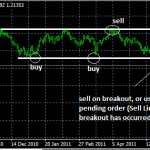Trading with Rectangles

The rectangle pattern is another chart pattern that traders should watch out for. This pattern is a continuation chart pattern that appears as a period of consolidation in the middle of a trend, with the asset resuming its move in the direction of the previous trend post-consolidation. Two trend lines can be drawn to connect the highs and the lows of the consolidating price candlesticks to produce the two sides of the rectangle. The trend lines are horizontal and parallel to each other.
The following conditions must be met on the charts before the rectangle pattern can be identified as one and traded accordingly:
a) The rectangle pattern is a continuation pattern, so there must be a prior trend.
b) There must be two candlestick highs and at least two candlestick lows, each of which must be connected with a trend line, and both lines must be parallel to each other. The price channel tool can be used to trace the lines and ensure that they are exactly parallel.
c) By the nature of their formation, the only true rectangles are seen on a daily chart, forming over a period of 3 weeks.
How to Trade the Rectangle Pattern
Two types of trades can be performed with the rectangle patterns.
a) Trading the rectangle range.
b) Trading the breakout.
Trading the Range
The rectangle is a pattern that forms over a period of weeks, so it is possible to trade many opportunities arising from the price shifting from one trend line to the other, before the breakout finally occurs. How do you trade the range?
a) Long Trade: The trader waits for the price action of the asset to settle on the lower trend line of the rectangle. There are clues that will tell the trader that there will be no breakout at this trend line.
- There will be a reversal candlestick formation.
- The candlestick tests the trend line support but closes above it, confirming that there is no breakout.
- One or both events mentioned above will occur at a time that the Stochastics oscillator registers an oversold status (<25).
When all these occur, the trader should go long at the open of the next candle, using the opposite trend line as the first profit target. The trader can use a trailing stop if the candle that hits the upper trend line cuts across that trend line, but if it does not close above that trend line to signal a break, the retreating price action will close out the trade at the trailing stop, locking in the profits.
b) Short Trade: The trader waits for the price action of the asset to settle on the upper trend line of the rectangle. If the following occur, then the trader can sell the asset short at the open of the next candle:
- A bearish reversal candlestick formation.
- The candlestick tests the trend line resistance but closes below it.
- One or both the events mentioned above occur at a time that the Stochastics oscillator is overbought (>75).
When all conditions have been met, the trader should go long at the open of the next candle, using the opposite trend line as the first profit target. The trader can use a trailing stop if the candle that hits the upper trend line cuts across that trend line, but if it does not close above that trend line to signal a break, the retreating price action will close out the trade at the trailing stop, locking in the profits.
Trading the Breakout
Even though the rectangle is typically a continuation pattern, the breakout can occur from any side. So the trader must be prepared. Instead of using the conventional pending orders, the trader can wait for the breakout to occur. The breakout can actually be spotted because on a daily chart, it takes a whole day for one candle to form. Once this has occurred, the trader can go long on a break of the upper trend line, or go short at the break of the lower trend line.
Alternatively, a pending stop order can be used on the trend line after a break, as prices sometimes retreat to these lines where they now act as new support (for upper trend line break) or resistance (for lower trend line break).


